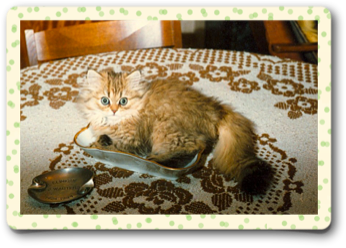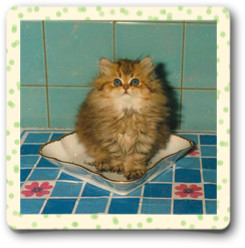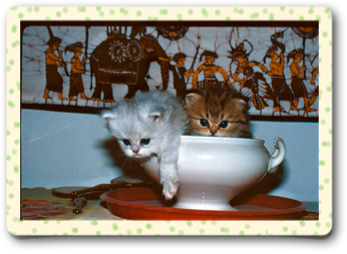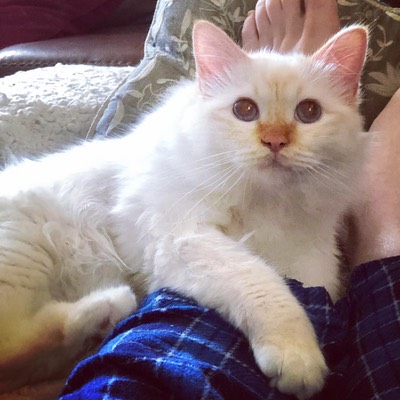
Since I was a small boy, I had always dreamt about having a cat. I think the Walt Disney movie, The Aristocats, might have had a strong impact on me too. We were living in a small apartment in the city and my parents didn't have any pets except small parrots that only my father could touch. The only animal close to a pet I "officially" owned was Pinocchio the red fish. I also had "secret" white mice that I kept outside, in a box, at school...
My parents used to put me in summer camps for three weeks, every summer. I do not know why, but I was always the one picked by cats in camps. They sneaked in, slept, ... and pee... on my bed! There was a special relationships between us!
I tried on several occasions to introduce a kitten in the house. It began with wild feral cats caught in the neighborhood’s backyard, but my father always sent them back, upset, menacing to kill them in the toilet, and I was left spreading all the water of my eyes!
Then, the promised day came after my bachelor degree. I was by myself in an apartment and free of choice. Well, almost free of choice because my first rental contract stipulated that "not pet were allowed". I had mice in this apartment, provocative mice, and my landlord was living in Switzerland 10 months per year. I did try to get rid of the little rodents by several meanings but without any success, they were spreading like ... mice ... and, after a while, did not bother to escape when I returned home. So ... I had to do something ... and this provided a good excuse to introduce .... a Cat in the House!
Thus, my decision was made. But, what kind of cats would I have? I decided to buy a book about cats. It was the “Larousse du Chat”, an encyclopedia that listed all the breeds. In one day, I had read the entire book and my eyes were amazed by the beautiful picture of one striking feline ... A Seal-Point Birman. I was mesmerized when I saw it! My search was completed.
I took the yellow pages, called the Cat Club of Belgium, and asked for information. A Cat Show was going to take place that week-end in Bastogne, so I went. I had never been to a Cat Show and was quite excited. There were, indeed, two magnificent Birman kittens for sale, from Germany, but the price was prohibitive, over my small budget and I couldn't afford one.
I came back home sad and read the book again. I had to pick up a cheaper breed! Another breed that had got my attention was the Persian Colorpoint, so I called the Cat Club again and was referred to a Persian breeder in my city (cattery of Gofforth). I went to visit her. She had a female seal-point for sale and asked me if I also want to take her brother, for the same price. He had heart problems (a deformation) and she was not sure how long he might live (he died in fact from a heart attack, months later). I took the two and came back home with my new cats. As I became friend with this breeder, I found myself quickly involved in Cat Shows...
My mother had begun the last phase of her leukemia, but was not aware of it, and the doctor gave me hope first. I decided to get her a companion cat as we were not living on the same side of Brussels. My heart was still set on Birman. I was able to acquire a pet quality blue-point female named W’Aril a san (from Dutch origins: Snozepoesjes) that I soon re-baptized Wickie, from the Kleetbos cattery, Mme Nadine Mellaerts, for a reasonable price. I didn't really chose Wickie. She picked me. I knew -at that time- close to nothing about Birman standard extreme specifics. She had irregular gloves, one runner, and was not show quality at all, but she had an outspoken personality. Amidst all the kittens for sale, she came straight to me and fell down inside my hand, as saying : "You are the one, take me with you, pleassssse!" That's how I chose her, with my heart. I gave the cat to my mother. Unfortunately, my dear mother passed away on August 23, 1986 and I took Wickie back with me. One week later, to change my mind, I put her in a cat show in Waterloo, on August 31, 1986 and the judge (Mr. Rossi) asked who had put this kitten in the show, because she was really not a show quality! I was embarrassed but was such a rookie at that time. She made Excellent 2nd female as there was only three kittens in her 3-6 months class! I still have the judgment which reads: “Front gloves too high with a runner. Nice back gloves but high. Nice head with contrast and good eyes. Ears well placed and contrasted. Excellent coat. Well presented, uniform. Excellent tail well contrasted. Excellent condition except for the gloves!”
Wickie (our 1st Birman)
Wickie was the beginning of my cattery, my first generation of Birman. In becoming a member of the Cat Club de Belgique, led by Mme Rossi at that period, I find myself involved with secretary work with Mme Rossi. I also met Birman breeders.
- 1st Du Laddak Doré Generation:
I had no male and became friend with the Antoine (Andara & Chidwin cattery), the main Birman breeders in Belgium at that time. They had a blue-point male stud named Ricky Jachara (from Holland’s lines: Snowepoesjes) that was, as a matter of fact, the grand-father of my cat (as I discovered later), and I mated Wickie with him, on January 20, 1987. Wickie gave birth to my first four kittens, on March 22, 1987, a Sunday, 61 days later. They were, of course, all blue-point, one male and three females: Arakhan, Amanda, Ava and Amara-Pura. None were show quality, of course. As I needed a cattery affix name to record them, my Persian Colorpoint friend, Mme Verzin, told me I could use her name and they were de Gofforth.
At the same time, meanwhile, I presented a blue-cream colorpoint Persian in the Brussels’ annual big January Cat Club de Belgique show that made the Best in Show Kitten 6-10 months. I had acquired her from my colorpoint breeder friend’s cattery.
I was very lucky to have my four Birman kittens on the television Animal weekly Show, because my vet (Dr. Yvan Beck) was a very famous university vet in charge of the pet TV programs on RTL. So, with my little knowledge of Birmans, I had 5 minutes on National TV.
Mme Antoine was also doing Persian Chinchilla at that time. She had a female silver, named Tania that she was trying to place somewhere, as it didn’t fit her program. She asked me if I want to take her. She had been rescued from a traumatizing place and was hiding most of the time. I felt compassion for this cat and took her with me. I was interested by Golden Shade Persian, a quite rare color at that time. When Tania was in heat, I went to Holland and mate her with a Golden-Shaded Persian named Esteban (Mme Alstede). From this mating, I got two kittens in August 15, 1987: one silver male Persian, Argentin and one Golden Shaded Persian female, Ophyre that I sold to a Persian chinchilla breeder in Belgium.



From the four Birman kittens, I kept one female: Amara-Pura de Gofforth.
In November 1987, I left Belgium to work with poor people in Haiti. I placed my three cats in some friends’ house, waiting for my return.
Three years later, in 1990, I came back to Europe and moved to Roquebrune Cap-Martin, in France, and worked one year at Beausoleil, above Monaco (where I was born). This was the originated area where the first Birman had been created in the 1920s. From my previous work, I was only able to recover one cat: Amara-Pura du Laddak Doré.
I registered an official name for my cattery in 1990 at the French, Federation Feline Française, after a visit to Laddak, in India, and called it : Du Laddak Doré. Cattery # 7.93.4843. The addition of Doré to my affix was a reference to Buddhist temples I had seen in Laddak, and well represented also in Burma, the country of the Birman cat legend.
Amara was the mother of the first Birman kittens with this affix name. This became official on July 19, 1991. Amara was mated with a Blue-Point male named Felipe du Chêne Heureux (La Perle d’or and La Renouée behind) and she gave birth to three kittens, one male and two females, all blue-point: Globule, Glycine and Guimauve. I kept Glycine du Laddak Doré.
In 1992, I moved back to Belgium, in Rixensart. Glycine was mated with one of the first Seal-Tabby Birman in Belgium, imported from England: Julipaul Tigerface. She gave me three kittens, on February 22, 1993, 3 females. One seal-point, Iris du Laddak Doré, one blue-point, Isis du Laddak Doré, and one blue-tabby-point, Idylle de Printemps du Laddak Doré (my favorite girl and first tabby-point). She had nice blue eyes, nice big gloves, but the right one was too high. I kept her. The Blue-Point girl, Isis, went to Limelette, to Mme Ska Clara, and the seal-point male, Iris, to Mr. Moureaux in St Jeangeest.
Iris du Laddak Doré (02-22-1993) - 16 y.o. here.
Isis du Laddak Doré (Capucine) (02-22-1993)
In February 1993, Amara was mated with a seal-point from another Birman cattery I knew: Alandor de Grand Lahou. She gave birth to two kittens. I kept a female seal-point named Isabeau du Laddak Doré. She had the look of the Perle d’Or. Glycine was in heat again later that year and was mated to Alandor de Grand Lahou. She gave birth to three seal-point kittens, two males and one female: Irish-Coffee, Impetuo and Indian-Lady. Irish-Coffe went to live in France in a small village (Yvernaumont) with a mayor lady, Mme Manil and her two dogs. Impetuo du Laddak Doré went to live with a nice lady in Brussels, Mme Valérie Vergeot.
- 1994 was the worst year for du Laddak Doré. I went to breed Glycine to the same place with Alandor and discovered the lady (a vet!) had just acquired another nice blue-point male left over somewhere. In studying the pedigree, I discovered this cat was a descendant from one of the cat I had admired the most in Belgium (Basilic Bleu-Nuit de Maoucha - imported by the Antoine not in business anymore) in shows, years before. She had just acquired this beautiful cat a week before and I asked to breed him with Glycine. Little, did I know that this cat had a virus, trusting a vet, and Glycine died quickly and infect the rest of my cats (this male cat died too). I lost most of my cats but was able to save Idylle de Printemps but not her ability to breed again. Amara, fortunately, was living with a friend at that time.
This event was an awakening to me. While the lady vet refused to recognize any responsibility, I was disgusted and I decided to work differently. This was the beginning of my search for a male of my own to work in a safer environment.
I did several mating with Amara and Apollon du Val de Gwen in La Louvière area (Mme Neeman Regine), a nice seal-point stud. Three kittens were born in 1994: Jaïpur, Jena and Java du Laddak Doré. Mme Valérie Vergeot from Bruxelles, bought her second cat from me: Java du Laddak Doré (and nicknamed her Galopette) to add a companion to Impetuo (her half-brother). Amara-Pura was spayed (she was already living with friends), thus ending this first generation.
Impetuo du Laddak Doré

Java du Laddak Doré
- 2nd du Laddak Doré Generation (new line):
I decided to buy a new female from Mme Neeman, and picked up a nice seal-point girl named Jade du Val de Gwen (03-19-1994). She is the second new generation of du Laddak Doré (Julipaul Tigerface line).
She was mated with Apollon du Val de Gwen in April 1995 and gave birth to three kittens, one female and two males, all seal-point: Lexie, Lautrec and Lafayette du Laddak Doré. Lexie was bought by Mme Malache Anne who came later for stud service with Insolite.
Lexie du Laddak Doré (1995)
I also decided, at that time, to buy a blue-point male from France, Lyon area. It was Junior du Manoir de St Goustan (07-22-1994). I went to Paris to pick up the cat at the Lyon Railway Station and came back with him by car. I isolated him from my cats and noticed he had some eczema and tinea. I went to visit my vet directly to give him a treatment but he was not looking very well. The poor boy died from FIV in not even 3 weeks! His mother had disappeared in nature, In Lyon and never came back. I had the most annoying bad luck and more sadness to add to my previous adventures. I was back to zero on my male quest. I almost got a nice seal-point male from Germany (Hamlet de Bassecour) but it did’t happen.
Junior du Manoir de St Goustan
Finally, perseverance was fruitful. In 1996, I was able to locate a seal-point male 3 y.o. for sale in the Brussels area, sold by a breeder who was stopping breeding at that time, and who happened to be ... the breeder of my first Birman cat (Kleetbos)! The spectacular, all in fur male she was selling was in fact a Parisian cat, Insolite de la Rose des Vents (03-28-1993). This was the nice combination I was hoping for.
Insolite de la Rose des Vents (Breeder: Mme Claudel)
Insolite was mated with Jade for the new generation. In 1996, he gave birth to four seal-point female kittens on 08-02-1996: Mandalay, Mélodie Enchantée, Marilyn and Marquise de Charme du Laddak Doré. These were my first quality show kittens produced. I kept Mandalay and Myosotis du Laddak Doré who was magnificent and won all the shows. Mandalay did also well in the Mouscron Cat Show in 06-02-1996 where she was Excellent 1st kitten 3-6 months, Best of Variety and Best in Show. Myosotis also made the Best in Show in 1997, beating all the other Birman present. Mélodie went to Wavre, to Mme Paule Soetewey; Mandarine to Bruxelles, to Mme Riss Heddy.
Jade was put again with Insolite and gave birth to 6 fat kittens, 3 females and 3 males, all seal-point: Mandarine, Myosotis, Mimiou, Mistral, Mandrin and Mirabeau du Laddak Doré (06-25-1996). It was a magnificent litter. The prettiest one was Myosotis and then Mandrin. Ironically Mistral du Laddak Doré was the lowest quality in this group (he is the one that is found in many pedigrees today via the cattery of la Baie des Anges and du Mas d’Orphée. He is the grand-father of Timo du Mas d’Orphée). He had, according to my notes, a left runner, short front gloves, however a very pretty head and a magnificent coat and nice strong morphology.
Myosotis has also repoduced and is found in North of France’s lines.
Myosotis du Laddak Doré
Made in USA
In 1998, I moved to the United States (Boston area, MA, and Storrs Connecticut) where I completed my education and began long studies leading to my PhD in French Literature.
In 2000, I was able to have Mandalay shipped to me to Boston from Brussels. I tried without success to have Myosotis back (my best female), but she was stolen from me with many lies (she had one more litter under my cattery name without my authorization (04-29-1998)- as I discovered by coincidence through pedigrees studying) and I never got her back or heard any news from her. This is one of my main regret as she was magnificent for these days standard.
Mandalay du Laddak Doré
I recorded my cattery name at CFA & TICA, but had to drop de DORE part because US Cat clubs only accept one word name. This is why the name now is Du Laddak (or Laddak) only.
Having no male I looked for an available stud in CT and found the Elpis cattery (Corinne - Elpis Cattery) and began to work with her and her blue-tabby-point male: Champion Taron Xerxes of Elpis. He gave me Zimra du Laddak Doré, seal-tabby-point female who was the mother of Belladone du Laddak. Zimra du Laddak Doré was my first half-European / half-American girl. She gained her Championship in TICA Shows.
Zimra with her kittens
Arthur du Laddak (08-11-2003 - 2013)
NEW QUEST FOR A MALE
I began to look for a male at that time and bought Jedi (blue-point) in 2002, from the Taron’s cattery in North Carolina, during the annual Birman Cat Show on the East Coast. Unfortunately we discovered that he had some strabismus as underlined by a judge. We had to neuter him and could not use him. He is still living with my friend Dr. Anne Berthelot in CT.
At the next Birman 2003 annual show in New Jersey, we bought Silkfire Adagio. He was a magnificent Chocolate-point cat from American and Australian lines (Belshogar cattery). Adagio won all the prices in Cat Show and became my First Supreme Grand Champion in TICA. He was the Best regional Birman cat in New England for that season. Unfortunately he had come to me with FIP and died in January 2005, at not even 2 years of age. I was devastated.
Silkfire Adagio of du Laddak
The TICA show where Adagio became:
Supreme Grand Champion Silkfire Adagio of du Laddak
(06-05-2003 - † 01-2005)
Chief Cowan du Laddak (08-19-2005)
Diego du Laddak/Samuraï (Blue-Tabby-Point) (05-2006) beside his mother’s picture. He is the last du Laddak from the 2nd generation.
- 3rd New Generation du Laddak (new line)
2010 - today After a four years halt, we finally got the right lodging conditions to resume again. Learning from our past experiences; knowing what we are looking for, and aware of the downside of breeding and the dangers paved on the road, we want to stay small, healthy, to produce strong loving cats and therefore, have become very picky in what we are looking for. You can check the other pages to discover the new generation in San Diego, CA.
In 2019, we have two females and three males actives.
In Memoriam.
Marin † 2010 (a little loving baby bird I tried to save.
He was killed by another bird while learning to fly… ;-(


